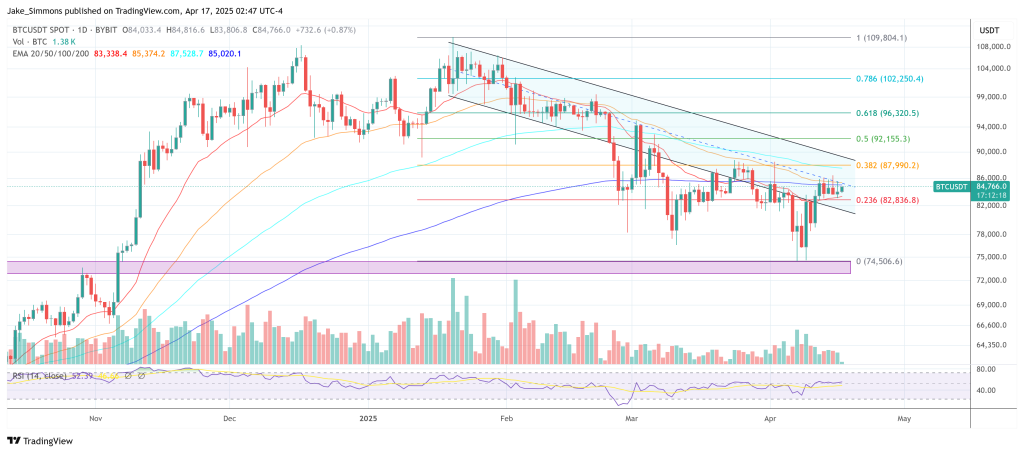Cause to belief
Strict editorial coverage that focuses on accuracy, relevance, and impartiality
Created by business consultants and meticulously reviewed
The highest requirements in reporting and publishing
Strict editorial coverage that focuses on accuracy, relevance, and impartiality
Morbi pretium leo et nisl aliquam mollis. Quisque arcu lorem, ultricies quis pellentesque nec, ullamcorper eu odio.
Este artículo también está disponible en español.
Bitcoin could also be trapped beneath the gravitational pull of pressured deleveraging, however macro strategist and Ahead Steering host Felix Jauvin insists that the clearing of danger books is not more than “the prelude to an incredible trade once the degrossing is over.” In a thread on X, Jauvin stitches collectively fiscal arithmetic, world liquidity metrics and the geopolitics of commerce to argue that the subsequent nice impulse for BTC will arrive when capital flows which have underpinned US asset dominance reverse and re‑seed danger urge for food overseas.
Bitcoin Amid The Trump Chaos
Jauvin begins by borrowing the empirical spine of Michael Howell’s work. “Bitcoin is primarily driven by global liquidity,” he writes, citing Howell’s Granger‑causality exams that give liquidity an eleven‑week statistical lead on spot costs. Fairness‑model beta “is a spurious correlation,” Jauvin argues, as a result of US equities have merely been the channel via which world greenback liquidity has expressed itself since pandemic‑period deficits swelled Treasury issuance and family incomes directly.
Placing numbers to the declare, he notes that america has “run a substantially higher fiscal deficit as % of GDP than any other country,” a niche that “mechanically leads to higher inflation, higher nominal GDP, and therefore higher top‑line revenue for corporations.” By extension, the S&P 500—and more and more Bitcoin—have monopolised incremental danger capital. “Because of this dynamic, US equity markets have been the dominant marginal driver of risky asset growth, wealth effect, global liquidity, and therefore a vacuum for global capital to go where it’s treated best: the USA.”
Associated Studying
Jauvin’s inflection level is the Trump marketing campaign’s declared ambition to compress the commerce deficit and prod allies into heavier fiscal outlays for defence and infrastructure. “The Trump administration wants to lower trade deficits with other countries, which mechanically implies a decrease of US dollars flowing to foreign countries that will not be reinvested into US assets,” he writes. A paired goal is “a weaker dollar and stronger foreign currencies,” achieved as overseas central banks carry charges and buyers repatriate funds to reap that carry.
He sees the genie already inching out of the bottle: “Trump’s shoot‑first, ask‑questions‑after approach to trade negotiations is leading the rest of the world to unshackle themselves from their meagre fiscal deficits … I believe nations will continue with this pursuit regardless.”
If overseas governments embark on deficit‑financed rearmament and industrial coverage, the marginal progress in world liquidity would migrate out of Washington and into Europe and Asia. “As the US continues to pivot from a global capital partner to a more protectionist one, holders of US‑dollar assets will begin to have to increase the risk premium associated with these previously pristine assets and have to mark them with a wider margin of safety.”
Why Bitcoin, And Why After The Promote‑Off
Jauvin frames the current turmoil as the mandatory purgation of crowded positions: “The first trade is to sell US‑dollar assets that the entire world is overweight and avoid the degrossing that is ongoing.” Margin exhaustion forces funds to lift money indiscriminately, pinning Bitcoin to tech beta for now. However, he insists, the second section will favour property unburdened by nationwide accounts or tariff danger. “During rotational market days and non‑margin‑call days, we’ve started to see this dynamic take shape. DXY down, US equities underperforming ROW, gold soaring, and Bitcoin holding up surprisingly well.”
Associated Studying
Gold has already responded, he notes. Bitcoin, against this, “hasn’t kept up with gold’s outperformance” as a result of its excessive‑beta repute retains systematic merchants on the sidelines. That units up the asymmetry: “For me, a risk‑seeking macro trader, Bitcoin feels like the cleanest trade after the trade here. You can’t tariff bitcoin, it doesn’t care about what border it resides in … and provides a clean exposure to global liquidity, not just American liquidity.”
Crucially, Jauvin anticipates a visual break within the co‑motion with US tech as soon as non‑US fiscal stimulus turns into the main supply of incremental liquidity. “I’m seeing the potential for the first time … for Bitcoin to decouple from US tech equities,” he writes, conceding that the thought has harm many earlier than however arguing that this time “we are seeing the potential for a meaningful change in capital flows that would make it durable.”
If the thread’s logic holds, the current stress is the necessary downstroke earlier than a secular re‑ranking. “This market regime is what Bitcoin was built for,” Jauvin concludes. “Once the degrossing dust settles, it will be the fastest horse out of the gate. Accelerate.”
At press time, BTC traded at $84,766.

Featured picture created with DALL.E, chart from TradingView.com


